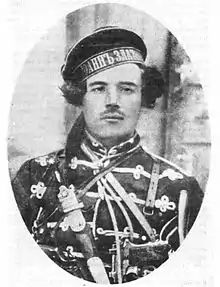Fedir Shchus
Fedir Shchus (Ukrainian: Федір Щусь, March 25, 1893 – June 30, 1921), also Fyodor Shuss or Feodosiy Shchus, was a commander (ataman) in the Revolutionary Insurrectionary Army of Ukraine of Nestor Makhno.[1] Schus played one of the most important roles in the history of both the Makhnovist movement and the civil war in general. He became a symbol of rebellion.
Fedir Shchus | |
|---|---|
 | |
| Born | March 25, 1893 Dibrovka, Yekaterinoslav Governorate, Russian Empire, now Velykomykhailivka, Dnipropetrovsk Oblast, Ukraine |
| Died | June 30, 1921 (aged 28) Nedryhailiv, Poltava Governorate, Ukrainian SSR |
| Allegiance | |
| Rank | Commander (Атаман) |
| Commands held | Revolutionary Insurrectionary Army of Ukraine |
| Battles/wars | Russian Civil War |
Origin
Shchus was born to a poor Ukrainian family in a small village Dibrovka in Yekaterinoslav Governorate in the Russian Empire (now Velykomykhailivka, Dnipropetrovsk Oblast, Ukraine).
World War I
In 1915 he was conscripted into the military service and enlisted in the navy as a seaman on the Ioann Zlatoust, a battleship in the Russian Black Sea Fleet. He did a lot of sports in the Navy, was a champion in French boxing and wrestling, and knew jiu-jitsu well, he was able to defeat any opponent with a quick capture without much stress.[2]
During his time in the navy, he became influenced by anarcho-communism. With the collapse of the fleet, he joined one of the detachments of revolutionary sailors.
Civil War
In 1917 he returned home and became one of the most active members of the Black Guards, an anarchist organization in Huliaipole. There he organized his own partisan detachment. Schus adhered to an extravagant style: his horse was decorated with ribbons, flowers and pearl necklaces on its legs.[3] He himself was dressed in an embroidered hussar uniform, he put on a sailor cap, wore a Caucasian dagger around his neck, and behind his belt was an old saber and a Colt revolver. He tended to embark on dashing, but not always justified raids, his courage rivaled only by his enthusiasm.[4]
From June 1918 - as commander of this partisan detachment, he fought against the Germans and the Austrians. After suffering a defeat, he joined Nestor Makhno in the Revolutionary Insurrectionary Army of Ukraine. From February to May 1919 - he was a member of the 3rd Zadniprovsky brigade. From July to August 1919 - he was the head of the brigade's cavalry, and from September to December - the commander of the 1st cavalry brigade of the 1st Donetsk Corps. From March 1920 to April 1921, he was a leading member of the Rebel Army. From May to June 1921 - he was chief of staff of the RIAU's 2nd group.
He was killed in June 1921 near Nedryhailiv in battle with the 8th Cavalry Division of the Red Cossacks. He was struck by a machinegun and either died on the spot or from his wounds. He was buried in a field without a grave so members of the Red Army could not desecrate it. But rumors of an important death on the Black side spread, and the Reds thought that they had killed Makhno. Shchus's grave was found, and his body was unearthed.
References
- Smele, Jonathan D. (November 19, 2015). Historical Dictionary of the Russian Civil Wars, 1916-1926. Rowman & Littlefield Publishers. p. 1024. ISBN 978-1-4422-5281-3.
- Dybets S. S. Compositions. - p. 129-130.
- Sosinsky “The Will of Russia” Prague, 1927, p. 41
- A. Nikolaev. The first among equals. - page 58